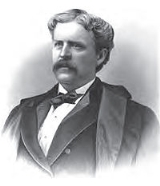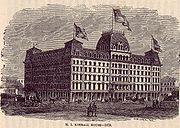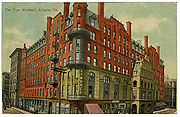
Hanniball Kimball
Encyclopedia
Hannibal Ingalls Kimball (May 16, 1832 – April 28, 1895) was an American
entrepreneur and important businessman in post-war Atlanta, Georgia
.
to family of Methodist wheel-wrights. He was the fifth boy of 10 children by his father, Peter Kimball, a highly regarded wheel-wright, and his mother, Betsey Emerson.
 He stayed in that and the carriage business moving first to Norway, Maine then later to the largest carriage manufacturing center, New Haven, Connecticut
He stayed in that and the carriage business moving first to Norway, Maine then later to the largest carriage manufacturing center, New Haven, Connecticut
where he partnered with his brothers to form a company that was later taken over by G .& D. Cook & Co Carriage Makers., Kimball was made partner in the company after the take-over. Many of their customers were in the South, and after the beginning of the American Civil War
many debts went unpaid, and the business failed.
The carriage company flourished, and by 1860 had over 300 employees. Kimball and George Cook
also invented a top-prop for carriages. The patent was issued on December 27, 1859
In 1858, Kimball married Mary Cook, the eldest daughter of his business partner, George Cook
. Kimball then moved to Central City, Colorado
as the agent for a mining company and regained his fortune. While in Colorado, he met George Pullman
who hired him in 1866 to establish the Pullman Company
's sleeping car lines in the South. Initially to be headquartered in Nashville, Tennessee
, he decided on Atlanta, moving his family there in 1867.
Kimball was the father of American printer Ingalls Kimball
, born April 2, 1874 with the same full name, Hannibal Ingalls Kimball.
to Atlanta. In 1868, shortly after the congress agreed to move the capital, Kimball purchased an abandoned opera house and constructed the first capitol building
. The building was completed in only 4 months, after which it was leased to the city, which then agreed to provide it without cost to the state for 10 years. The next year, the Georgia Legislature purchased the building, with the city paying $100,000 for part of the cost permanently making Atlanta the capital of Georgia.
On March 16, 1869, Kimball along with Edward N. Kimball, John Rice
, John C. Peck
, and Jame A. Burns incorporated the Atlanta Canal and Water Company. The company had previously been incorporated to cut canals from the Chattahoochee River
into and throughout the city streets for sanitary and other uses. However, the previous company had not completed any work on the project. The new Atlanta Canal and Water Company would thus construct Atlanta's first sewer system.
 Prior to the fair Atlanta lacked suitable accommodations for visitors. On March 29 Kimball purchased the old Atlanta Hotel
Prior to the fair Atlanta lacked suitable accommodations for visitors. On March 29 Kimball purchased the old Atlanta Hotel
lot and built "The H. I. Kimball House" at a cost of $675,000. Wallace Putname Reed, an Atlanta historian once declared that it was "equal in all respects to the fifth Avenue Hotel in New York and far superior to anything in the South."
When the hotel was completed, Kimball turned his efforts toward improving the surrounding area. The area of Atlanta bounded by Pryor, Decator, Lloyd, and Alabama streets was home to a decrepit railroad car shed. Another area known as the "Mitchell heir property" was reclaimed by the heirs of Robert Mitchell
under protest of the government after the railroads abandoned the land. The city claimed that it had a right to the land since it was originally traded for a different property. Kimball, seeing the detriment to his own property by these other lands, paid the city for the lands and build a new rail depot.
Kimball was also active in railroad construction throughout Georgia and the South. He was at one point president of 9 different railroad companies. And by 1871, he had constructed some 300 miles (482.8 km) of track. Kimball lost most of his railroad interests shortly after the Great Chicago Fire
in 1871.
 Kimball was in Chicago, Illinois on August 12, 1883 when a letter arrived notifying him that the Kimball House had burned to the ground. The fire fighters were able to contain the fire and no other buildings and no lives were lost. By November 12, he began building a new hotel that was to be larger and finer than the previous one. The new H. I. Kimball House was completed on April 30, 1885.
Kimball was in Chicago, Illinois on August 12, 1883 when a letter arrived notifying him that the Kimball House had burned to the ground. The fire fighters were able to contain the fire and no other buildings and no lives were lost. By November 12, he began building a new hotel that was to be larger and finer than the previous one. The new H. I. Kimball House was completed on April 30, 1885.
Soon, at the dedication ceremony of the new chamber of commerce building, Kimball's friend Henry W. Grady
proposed holding a great commercial exposition in the city within two months. Kimball was made chairman of the exposition and traveled the country gaining support for the effort. The exposition commenced with over 500 delegates from 33 states who met in the De Gives Opera House on April 19, 1885.
as president and Kimball as general manager. This land would later be the site of the Georgia Institute of Technology
, then known as the Georgia School of Technology.
He was a major figure there until scandals at the end of Radical Republican power in the early 1870s but he made two significant returns to town.
United States
The United States of America is a federal constitutional republic comprising fifty states and a federal district...
entrepreneur and important businessman in post-war Atlanta, Georgia
Atlanta, Georgia
Atlanta is the capital and most populous city in the U.S. state of Georgia. According to the 2010 census, Atlanta's population is 420,003. Atlanta is the cultural and economic center of the Atlanta metropolitan area, which is home to 5,268,860 people and is the ninth largest metropolitan area in...
.
Early years
Born in Oxford County, MaineOxford County, Maine
Oxford County is a county located in the U.S. state of Maine with a population of 57,833 as of the 2010 U.S. census. Its county seat is Paris.Part of Oxford County is included in the Lewiston-Auburn, Maine, metropolitan New England City and Town Area while a different part of Oxford County is...
to family of Methodist wheel-wrights. He was the fifth boy of 10 children by his father, Peter Kimball, a highly regarded wheel-wright, and his mother, Betsey Emerson.

New Haven, Connecticut
New Haven is the second-largest city in Connecticut and the sixth-largest in New England. According to the 2010 Census, New Haven's population increased by 5.0% between 2000 and 2010, a rate higher than that of the State of Connecticut, and higher than that of the state's five largest cities, and...
where he partnered with his brothers to form a company that was later taken over by G .& D. Cook & Co Carriage Makers., Kimball was made partner in the company after the take-over. Many of their customers were in the South, and after the beginning of the American Civil War
American Civil War
The American Civil War was a civil war fought in the United States of America. In response to the election of Abraham Lincoln as President of the United States, 11 southern slave states declared their secession from the United States and formed the Confederate States of America ; the other 25...
many debts went unpaid, and the business failed.
The carriage company flourished, and by 1860 had over 300 employees. Kimball and George Cook
George Cook
George Cook, was an English opera singer, best known for his performances in the bass and bass-baritone roles of the Savoy Operas with the D'Oyly Carte Opera Company...
also invented a top-prop for carriages. The patent was issued on December 27, 1859
In 1858, Kimball married Mary Cook, the eldest daughter of his business partner, George Cook
George Cook
George Cook, was an English opera singer, best known for his performances in the bass and bass-baritone roles of the Savoy Operas with the D'Oyly Carte Opera Company...
. Kimball then moved to Central City, Colorado
Central City, Colorado
Central City is a home rule municipality in Clear Creek and Gilpin counties in the U.S. state of Colorado, and the county seat of Gilpin County. The city population was 515 in the 2000 United States Census...
as the agent for a mining company and regained his fortune. While in Colorado, he met George Pullman
George Pullman
George Mortimer Pullman was an American inventor and industrialist. He is known as the inventor of the Pullman sleeping car, and for violently suppressing striking workers in the company town he created, Pullman .-Background:Born in Brocton, New York, his family moved to Albion,...
who hired him in 1866 to establish the Pullman Company
Pullman Company
The Pullman Palace Car Company, founded by George Pullman, manufactured railroad cars in the mid-to-late 19th century through the early decades of the 20th century, during the boom of railroads in the United States. Pullman developed the sleeping car which carried his name into the 1980s...
's sleeping car lines in the South. Initially to be headquartered in Nashville, Tennessee
Nashville, Tennessee
Nashville is the capital of the U.S. state of Tennessee and the county seat of Davidson County. It is located on the Cumberland River in Davidson County, in the north-central part of the state. The city is a center for the health care, publishing, banking and transportation industries, and is home...
, he decided on Atlanta, moving his family there in 1867.
Kimball was the father of American printer Ingalls Kimball
Ingalls Kimball
Ingalls Kimball was an American printer and entrepreneur.-Early years:Born in West Newton, Massachusetts to American entrepreneur Hannibal Ingalls Kimball and Mary Kimball....
, born April 2, 1874 with the same full name, Hannibal Ingalls Kimball.
Capital of Georgia
One of his first tasks in Atlanta was helping to convince the constitutional convention of Georgia to move the state capital from MilledgevilleMilledgeville, Georgia
Milledgeville is a city in and the county seat of Baldwin County in the U.S. state of Georgia. It is northeast of Macon, located just before Eatonton on the way to Athens along U.S. Highway 441, and it is located on the Oconee River. The relatively rapid current of the Oconee here made this an...
to Atlanta. In 1868, shortly after the congress agreed to move the capital, Kimball purchased an abandoned opera house and constructed the first capitol building
Georgia State Capitol
The Georgia State Capitol, in Atlanta, Georgia, in the United States, is an architecturally and historically significant building. It has been named a National Historic Landmark and is listed on the National Register of Historic Places. It is the main office building of Georgia's government...
. The building was completed in only 4 months, after which it was leased to the city, which then agreed to provide it without cost to the state for 10 years. The next year, the Georgia Legislature purchased the building, with the city paying $100,000 for part of the cost permanently making Atlanta the capital of Georgia.
On March 16, 1869, Kimball along with Edward N. Kimball, John Rice
John Rice
John Rice may refer to:* John Andrew Rice, founder of the Black Mountain College* John B. Rice , U.S. Representative from Ohio* John Blake Rice , mayor of Chicago, Illinois, 1865–1869, and later a U.S. Representative...
, John C. Peck
John C. Peck
John C. Peck was a businessman and building contractor from Atlanta, GA. Peck is known for constructing some of Atlanta's most notable early buildings including the Kimball House hotels...
, and Jame A. Burns incorporated the Atlanta Canal and Water Company. The company had previously been incorporated to cut canals from the Chattahoochee River
Chattahoochee River
The Chattahoochee River flows through or along the borders of the U.S. states of Georgia, Alabama, and Florida. It is a tributary of the Apalachicola River, a relatively short river formed by the confluence of the Chattahoochee and Flint Rivers and emptying into Apalachicola Bay in the Gulf of...
into and throughout the city streets for sanitary and other uses. However, the previous company had not completed any work on the project. The new Atlanta Canal and Water Company would thus construct Atlanta's first sewer system.
1870 Agricultural Fair
In 1870, the city contracted Kimball to construct the grounds and buildings for an agricultural fair to be held that year. The project required over 60 acres (242,811.6 m²) of forest to be cleared and buildings constructed on the site. Six months later, Kimball completed the project and turned it over to the city and the State Agricultural Society. He was later contracted by the city to manage the fair.The First Kimball House

Atlanta Hotel
The Atlanta Hotel also known as Thompson's Hotel, was one of the original hotels in antebellum Atlanta, Georgia. It stood at the northwest side of State Square, prewar Atlanta's central square, on the northwest side of Pryor Street between Decatur Street and what is now Wall Street . The hotel was...
lot and built "The H. I. Kimball House" at a cost of $675,000. Wallace Putname Reed, an Atlanta historian once declared that it was "equal in all respects to the fifth Avenue Hotel in New York and far superior to anything in the South."
When the hotel was completed, Kimball turned his efforts toward improving the surrounding area. The area of Atlanta bounded by Pryor, Decator, Lloyd, and Alabama streets was home to a decrepit railroad car shed. Another area known as the "Mitchell heir property" was reclaimed by the heirs of Robert Mitchell
Robert Mitchell
Robert Mitchell may refer to:* Robert Mitchell , Canadian politician* Robert C. Mitchell , Canadian politician from Ontario* Robert Boyed Mitchell , Australian artist...
under protest of the government after the railroads abandoned the land. The city claimed that it had a right to the land since it was originally traded for a different property. Kimball, seeing the detriment to his own property by these other lands, paid the city for the lands and build a new rail depot.
Railroads
Along with the depot, Kimball also built tracks along Alabama street that resulted in the warehouse district moving to that location. He widened Pryor Street and constructed Wall Street. Capitalists came from New York, Boston, and beyond to invest in the area leading to $100,000 in profit for Kimball.Kimball was also active in railroad construction throughout Georgia and the South. He was at one point president of 9 different railroad companies. And by 1871, he had constructed some 300 miles (482.8 km) of track. Kimball lost most of his railroad interests shortly after the Great Chicago Fire
Great Chicago Fire
The Great Chicago Fire was a conflagration that burned from Sunday, October 8, to early Tuesday, October 10, 1871, killing hundreds and destroying about in Chicago, Illinois. Though the fire was one of the largest U.S...
in 1871.
International Cotton Exposition of 1881
Kimball did little in the years after his railroad business failed. Eventually he returned to the business scene and founded the Atlanta Cotton Factory. In 1880, a letter from Edward Adkinson of Boston was posted in the New York Herald suggesting that a cotton exposition be held in the South. Kimball seized the idea and invited Adkinson to come to Atlanta and help him rally support. The state legislature soon agreed to the idea and made Kimball Director-General of the 1881 International Cotton Exposition.The New Kimball House

Soon, at the dedication ceremony of the new chamber of commerce building, Kimball's friend Henry W. Grady
Henry W. Grady
Henry Woodfin Grady was a journalist and orator who helped reintegrate the states of the former Confederacy into the Union after the American Civil War....
proposed holding a great commercial exposition in the city within two months. Kimball was made chairman of the exposition and traveled the country gaining support for the effort. The exposition commenced with over 500 delegates from 33 states who met in the De Gives Opera House on April 19, 1885.
Peters Park
In 1884, Kimball secured funding to purchase 200 acre (0.809372 km²) of land fronted on West Peachtree Street and running west along North Avenue to construct roads and housing. A company was organized to manage the property with Richard PetersRichard Peters (Atlanta)
Richard Peters was an American railroad man and a founder of Atlanta.Grandson of Judge Richard Peters, Jr...
as president and Kimball as general manager. This land would later be the site of the Georgia Institute of Technology
Georgia Institute of Technology
The Georgia Institute of Technology is a public research university in Atlanta, Georgia, in the United States...
, then known as the Georgia School of Technology.
He was a major figure there until scandals at the end of Radical Republican power in the early 1870s but he made two significant returns to town.

